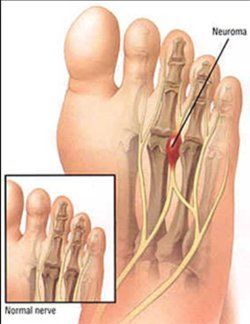Morton's Neuromas
What is Morton’s Neuroma?
Morton's neuroma refers to a nerve injury between the toes, usually the third and fourth toes, which causes pain and thickening of the nerve tissue. Compression or chronic irritation of this interdigital nerve is the leading cause of Morton's Neuroma.

Impact of Morton’s Neuromas on Anatomy and Health
Morton's Neuromas can impact your anatomy and health by causing pain, tingling, or numbness in the affected area, making walking or standing difficult.
In some cases, the pain can also radiate to other areas of the foot or leg, leading to further discomfort. However, with proper treatment and care, most people can manage the symptoms and maintain mobility and quality of life.
Causes and Risk Factors for Morton’s Neuromas
The exact cause of Morton's Neuromas is not fully understood, but it is believed to be caused by irritation or compression of the nerve tissue in the foot. Some factors that may contribute to the development of Morton's Neuromas include
- Wearing tight or high-heeled shoes that put pressure on the toes and ball of the foot.
- Participating in high-impact activities that stress the feet, such as running or jumping.
- Having flat feet, high arches, or other foot deformities can alter the distribution of weight and pressure on the feet.
- Being female, women are more likely to develop Morton's Neuromas than men.
Symptoms of Morton’s Neuromas
The symptoms of Morton's Neuromas can vary depending on the size and location of the growth, as well as the individual's foot anatomy and activity level. However, some common symptoms may include
- Pain or tenderness in the ball of the foot, particularly between the third and fourth toes or the second and third toes.
- Numbness or tingling in the toes.
- A feeling of having a pebble or lump in the shoe or sock.
- Burning sensation in the foot.
- Worsening pain when walking or standing and relief when resting.
- Radiating pain that extends from the ball of the foot to the toes or up to the ankle.
Diagnosis of Morton’s Neuromas
Diagnosis is usually made by taking a history and examining the foot, which includes:
- Palpation of the painful area
- Squeezing the foot can reproduce the symptoms and sometimes cause a ‘click.’
- Assessing for numbness of the nearby toes
- Differentiating from other conditions that cause metatarsalgia (pain on the ball of the foot) (see Metatarsalgia Information Sheet). Sometimes, these conditions can occur at the same time as a Morton’s neuroma, and so an injection with local anaesthetic and steroids into the neuroma can help diagnose it as the source of pain.
- X-rays, ultrasound or MRI, may rule out other conditions and identify any structural issues in the foot.
- Nerve conduction studies: nerve conduction studies may measure the affected nerve's electrical activity and assess the condition's severity.
Treatment of Morton’s Neuromas
Early treatment is critical to relieve pain. Mild to moderate cases of Morton's Neuroma can be managed by conservative treatment. Severe cases of neuroma may require surgery.
The conservative treatment measures include:
- Rest your foot and apply ice packs over the pressure and improve foot function
- Local anaesthetic injections to temporarily relieve severe pain
Surgery is considered the last option if the symptoms fail to resolve with conservative treatments (see Morton’s Neuroma Excision Surgery).
Why Consider Taking Action for Morton’s Neuromas?
- Pain relief: Morton's Neuromas can cause significant foot pain and discomfort, making walking or standing difficult. Treatment can help to alleviate pain and improve quality of life.
- Improved mobility: Treatment for Morton's Neuromas can help to improve mobility and reduce the risk of falls or other injuries.
